- /
- Valorant
- /
- Strategic Tactical Theory
STRATEGIC TACTICAL THEORY

Fundamental Concepts

Set of bases and principles that make up Valorant.
Space
Space is a concept that can be defined as: “The physical environment where the game takes place”. In Valorant, the main space is the different maps.
Important Aspects: Elements that compose a space and Structure.
Elements
All forms, objects and mechanics that make up a space.
- Corners (Inside / Outside)
- Ropes
- Boxes, Containers…
- Revolving Doors
- ETC…
Structure
Form of a space. In terms of analysis and planification, we have to take into account these two concepts.
Simple Structure – General structure, without being very specific.
Detailed Structure – Specific structure in which we take into account each element of the space.
– Basic Space Laws
“Without information, every uncontrolled space is an enemy”.
Note: In Valorant we must take into account that there are abilities that avoid others. For example: If we put a Cypher Cable to control the back, an Omen could pass it with its TP.
“Space = Information”
– The Importance of Space
Space is an extremely important concept, both in offense and defense.
Why?
ATK – Because in essence, to get to a Side and plant, we are forced to pass through previous zones. Following this idea, winning a zone prior to a Side and managing it, applies pressure to the defender. This generates a situation to which the defender has to adapt.
DEF – Because when it comes to prevent the opponent to reach the side and plant, the management of the previous zones is primordial. Even if you want to raise a Retake, you have to manage the previous zones.
These, for me, are the main reasons. Obviously it is a concept that is important in other aspects of the game. We will talk about them in other sections of the Web.
– Breaking down Space
Elements of space.
- Boxes

- Double Boxes
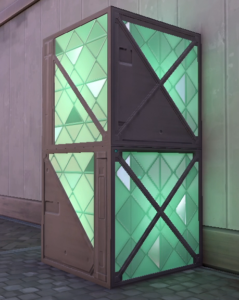
- Double Doors

- Windows
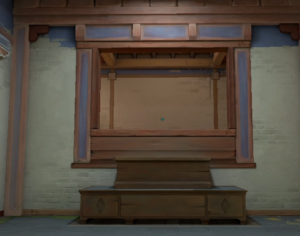
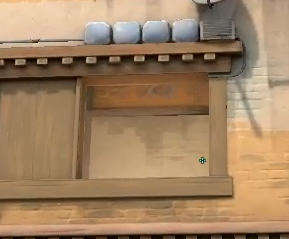
- Mini Windows
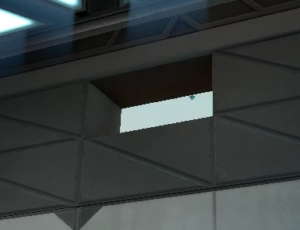
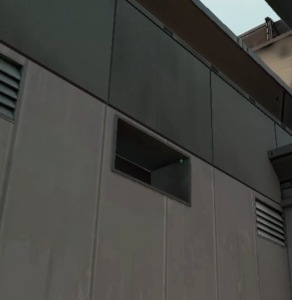
- Sewers
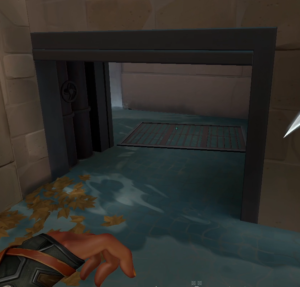
- Container
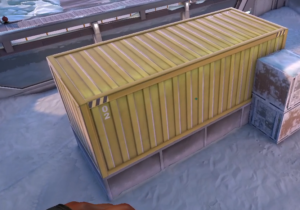
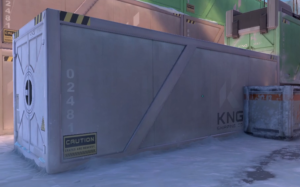
- Hollow Container
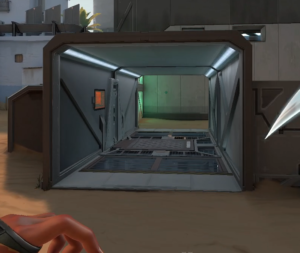
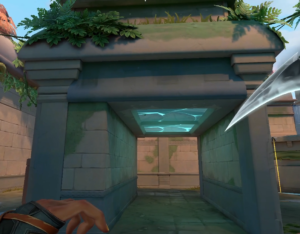
- Steps

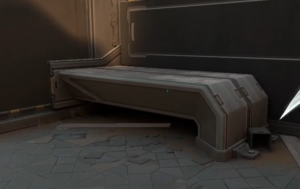
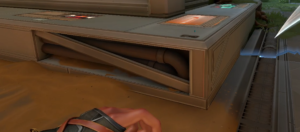
- Stairs/Ramps
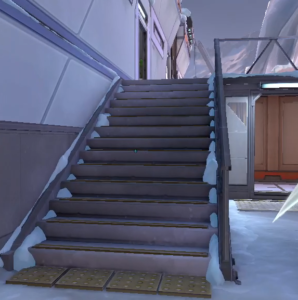
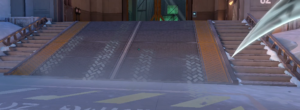
- Walls
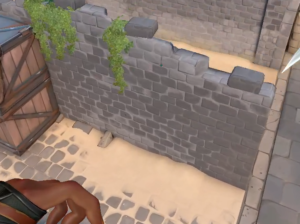
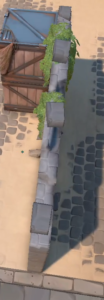
- Cylinders
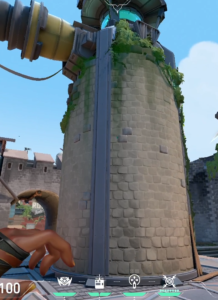
- Pyramids
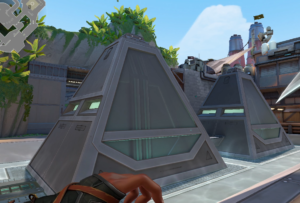
- Open Outside Corners
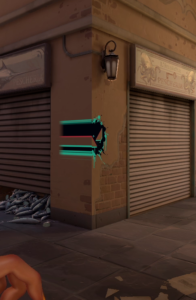
- Semi-Open Outside Corners
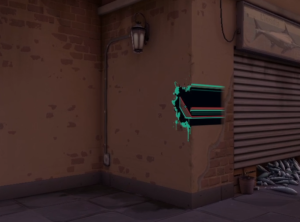
- Open Inside Corners
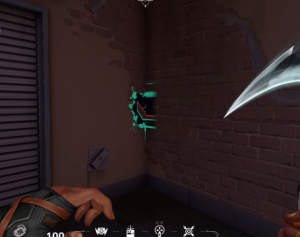
- Semi-Open Inside Corners
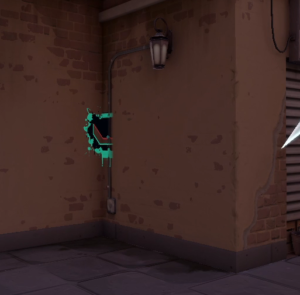
- Drops

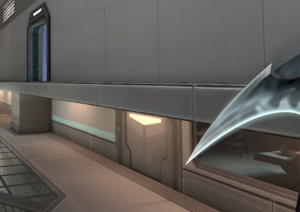
- Slips
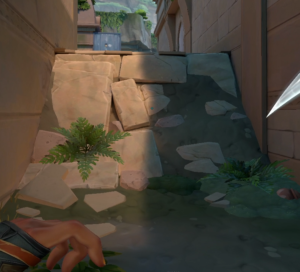
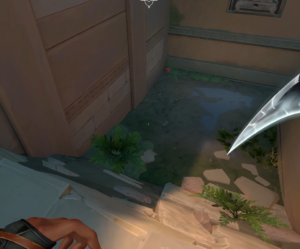
- Hills

- Horizontal Zip Lines with Interaction
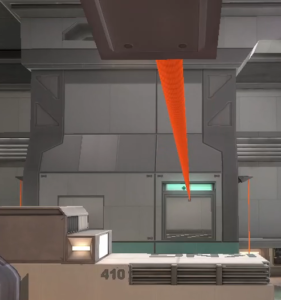
- Vertical Zip Lines with Interaction
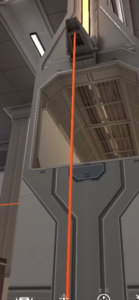
- Horizontal Zip Lines without Interaction

- Swinging Switch Gates – Unbreakable

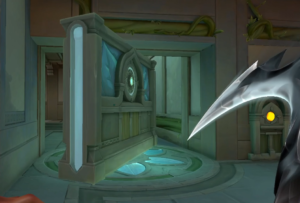

- Switch Doors – Breakable

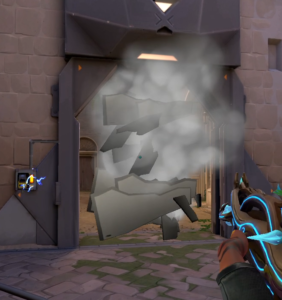
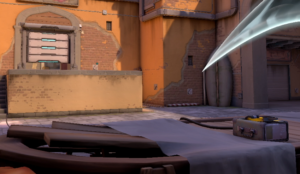
- Switch Doors – Unbreakable
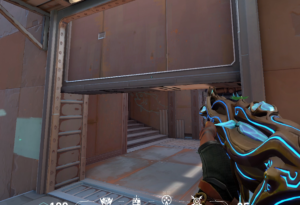
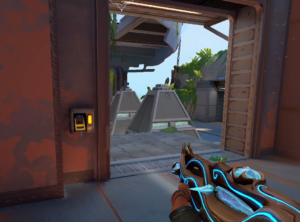
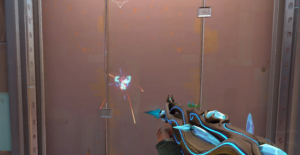
- Automatic Doors
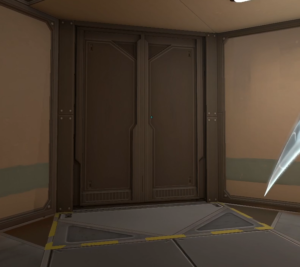

- Automatic Hatches

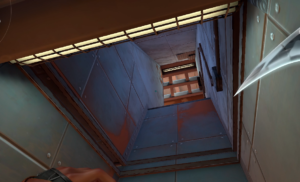
- Breakable Elements
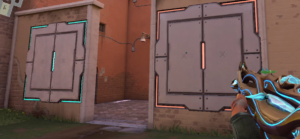
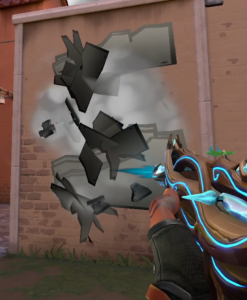
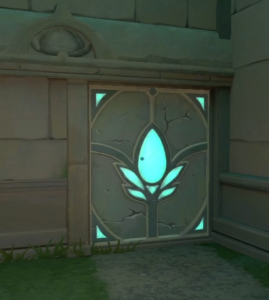
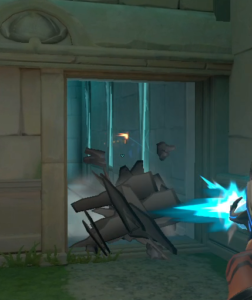
- Portals
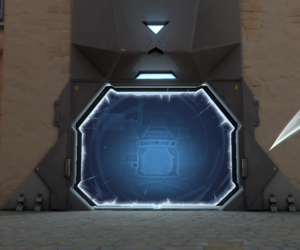
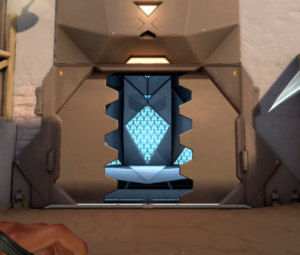
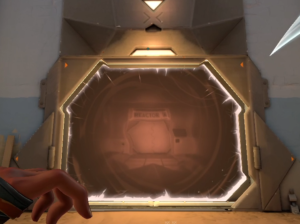
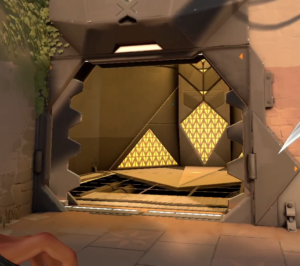
- Specific
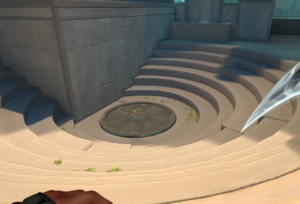

- Compounds

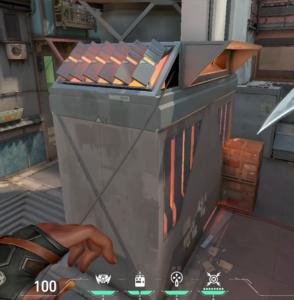

The fundamental aspect of the space elements – Support Point.
- To Pivot or Cover.
- To place in Unusual Positions.
- To favor or difficult a specific action.
Time
This is a concept that refers to the duration and tempos of all the particularities of a game.
Pistol Preparation
Spike Placement
Rotation Times
Skills
Etc…
Something important is that time is related to speed. Therefore, it is necessary to know and control the speeds to better manage the times.
Very Fast – Instantaneous
Action that is normally supported by skills related to that aspect.
Example
- Neon’s movement speed
- Packs of Raze
- From the Shadows of Omen
Fast
Vertiginous Actions. Which use a short range of time.
Intermediate
Intermediate Actions. That use a time range between a fast and a slow action.
Slow
Paused Actions. That use a wide range of time in their actions.
Very Slow – Freeze
Actions close to or applying inaction.
– Basic Laws of Time
“Attacking and in Retake, time runs against you”.
“Defending and in Postplant, time runs in your favor.”
“The longer the time, the more types of speeds can be applied”
“The shorter the time, the fewer types of velocities can be applied”
– The Importance of Time
The main importance of this concept resides in its basic laws. They must be respected and taken into account when managing a round. The time also has other interesting aspects, which we will discuss later.
– Breaking Down Time
Basic Times
Pipes Preparation 45s
Preparation Rounds 30s
Round 1:40s
PostPlant / Retakes 45s
Plant Spike 4s
Defuse Spike 7s (2 Parts)
Take Orb 2s
Timeouts 60s
Side Change 1:30
Skill Time in Agents section
Time of Rotations in the Map section
Information
As its name indicates, it is all the information that we have to manage inside and outside the game.
Sources of information
- Vision
- Noises
- Abilities
- Information “In Game”
- “NO Information” is also information
- Previous Information
Communication
It is the action by which this information is transmitted. And it has a fundamental role within a team. Especially within the game, where it has to develop in the right way.
– Basic Laws of Information
“Quality Information”
“Quality Comunication”
“The information we obtain during a round, has a dissolutive factor. This means that, if the information obtained is not capitalized on in a reasonable amount of time, over time it may change and you may not know it”
– The Importance of Information
It is the most important concept during the course of a game and a round, both defending and attacking. Its good management will put us in favorable situations.
– Breaking Down Information
Sources of information
Vision
Both what we see ourselves and what we see on the minimap.
Noises
- Environmental Sounds: Water, Metal, Concrete, Earth, Sand, Wood, Snow, Mud…
- Specific Sounds: Orbs, Doors, Ziplines, Breakage of some element…
- Weapon Sounds: Shooting, Slashing, Reloading and weapon falling to the ground.
- Sounds of Abilities.
Abilities
All information obtained from specific skills for it, for example:
- Sova’s recon arrow.
- Cypher’s camera.
Information “In Game”
It is all the information that is collected and transmitted during a game.
No Information
Precisely tells us that the enemy or we are deliberately denied our information. This also generates information about what we can be doing. For example:
- We are or they are playing passive.
- We are or they are advancing to contact.
Previous Information
It corresponds to the previous analysis of the opponent.
Energy
Everything related to the mental, sensations and performance of the players.
– Basic Laws of Energy
“Positivity + Negativity -”
“Deep Performance Development”.
– The Importance of Energy
Although strategically and tactically it is not as important as the other concepts, this plays a fundamental role. It is necessary to know how to manage the problems that the team may have in this area. In order to boost performance to the maximum.
– Breaking down Energy
Coming soon…
Matter
It is a concept that encompasses everything material. It is not part of the concept of space.
- Economy
- Weapons
- Abilities
- Players
- Orbs
- Spike
– Basic Laws of Matter
“Every resource is important, so every resource has to have its purpose”
“Every Skill and Weapon reaches its maximum potential, in a specific space”
“Joint Economy”
“Synergy and Coordination”
“2vs1 Better than 1vs1”
– The Importance of Matter
Matter is a concept that groups many aspects of the game. We will mention the essential importance of each one.
Economy: The most important thing is to be clear about the idea of, “Joint Economy”
Abilities: It is the most important aspect of tactics. It goes hand in hand with an essential word “Purpose”
Weapons: The most important thing regarding weapons is, their “Potential”
Players: The most important of this aspect are:
- Individual and Team Mechanics
- Agent Distribution
- Routes
Orbs: The most important thing is to take into account the definitive skills of both teams, to know how to play around that.
Spike: Essential artifact of the round. Interaction with it is one of the main means to victory.
– Breaking Down the Matter
Economy
Materials that can be purchased
- Weapons
- Shields
- Skills
Obtaining Credits
- Kills 200$
- Round Won $3000
- Lost Round 1900$ < 2400$ < 2900$ (Depending on the losing streak)
- Plant Spike 300$ (All the team)
- Defuse Spike 300$ (Only for the defuser)
Economic States
- FullBuy
Economic state in which we can buy all our skills, a shield and a weapon with great potential and versatility (usually Phantom, Vandal or Operator).
- SemiBuy
Economic state in which we don’t have enough credits for a FullBuy, but we can buy some material. In order to have more possibilities in the round and be able to make a FullBuy in the following round.
- Eco
Economic state in which we cannot buy anything. Otherwise we would not have FullBuy in the next round.
- Forced
Economic state in which we do not have money to make a FullBuy, but we still decide to use all our credits. Taking a risk and not being able to make a FullBuy in the next round.
Weapons and Shields
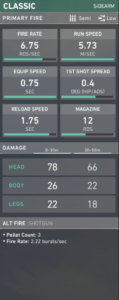
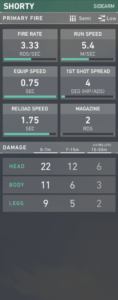
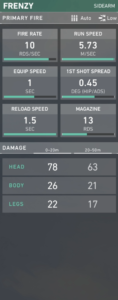
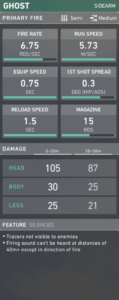
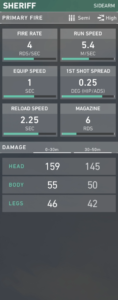
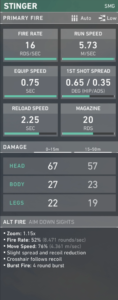
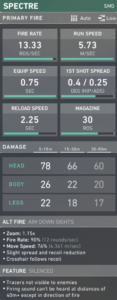
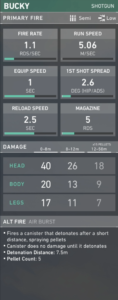
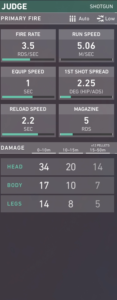
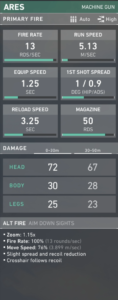



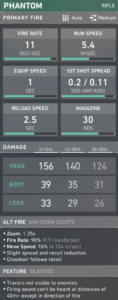
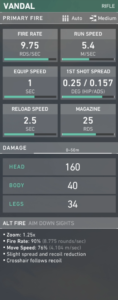
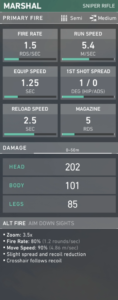
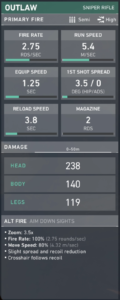
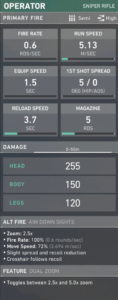
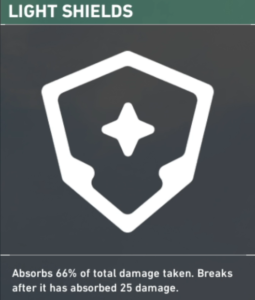
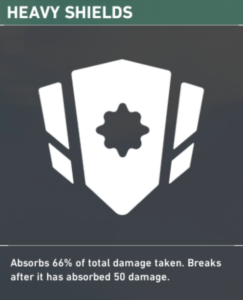
Skills
All types of Resources, unspecified.
- Mollys
- Grenades
- Smokes
- Blinding
- Myopias
- Deafness
- Stuns
- Slowdowns
- Healing
- Resurrections
- Fire Power
- Damage
- Movement Speed
- Fire Speed
- Reload Speed
- Impulsors
- Teleports
- Drones
- Decoys
- Spotters
- Catches
- Attractions
- Invulnerability
- Vulnerability
- Decay
- Silences
- Surveillance Systems
- Spike Management
- Immobilizations
- Barriers
- Ballistic Shields
- Isolation
Players
Individual Mechanics
- It is the ability of a player in different aspects of the game. Such as AIM, Shooting Mechanics, Peeks, Holds, Gamesense, Agent Mechanics and Communication.
Collective Mechanics
- It is the ability of a team in different aspects of the game. Such as Trades, CrossFires, Coordination, Communication and Gamesense.
Agent Distribution
- The way in which the Agents are organized at the beginning of the round and during the round.
Routes/Passings
- The route that either a group of Agents or a single Agent takes during the round.
Coming soon…

Compositions

In Valorant, composition refers to the group of 5 agents that make up a team. My idea in this section is that you should be aware of the different aspects when creating a composition. I will list them all separately, although in general they are all taken into account when creating a composition.
In the world of compositions everything is possible, just keep in mind that there are compositions with more viability than others.
Aspects
Resources
A composition can be developed on the basis of resources. That is, types of skills. Example:
I want or need, a composition that has Drones, Flashes and long distance Smokes.
- Gekko Skye Phoenix Harbor Viper
Agent – Player Synergy
A composition can be worked out based on the excellence of a player with an Agent. Example:
Paco: Is GOD Jett
Goku: Is GOD Yoru
JordiENP: Is GOD Breach
Ibai: Is GOD Astra
Mixwell: Is GOD Cypher
Synergy between Agents
You can elaborate a composition based on the synergy that several agents have, taking into account their abilities. Example:
- Fade Raze Gekko Harbor Sage
Map
You can elaborate a composition taking into account the map in which we are going to play. Example:
We play in Breeze
- Viper Sova Kyo Jett Cypher
PlayStyle
A composition can be elaborated based on the PlayStyle of the team. Example:
We have a Super Defensive team.
- Chamber KillJoy Viper Brimstone Skye
Strategy and Tactics
A composition can be elaborated based on the Strategy and Tactics proposed. Both offensive and defensive. Example:
On offense we are going to play to make executes. On defense we are going to play aggressive and we need a sentinel to stronghold a Side.
- Raze Breach Sova KillJoy Omen
Roles
A composition can be worked out with roles in mind. Example:
We want to make a composition with a duelist majority. For whatever reason.
- Reyna Neon Phoenix Brimstone Breach
Functions
A composition can be created around the possible functions to be performed. Example:
We will put some agents with affinity for Lurking and Strongholdear.
- Viper Omen Reyna Sova Gekko
Meta
A composition can be made by taking into account how strong an Agent is. Example:
We will use the Chamber when it was broken, to create a composition around it.
- Chamber Fade Breach Omen Yoru
Counter Meta
A composition can be elaborated taking into account the target composition. With the objective of annulling it.
Let’s counter the Chamber’s Meta.
- Kyo Sova Iso Harbor Cypher
Counter Composition
It is possible to elaborate a composition based on the opponent’s composition. With the purpose of annulling it.
Rival Composition
Cypher Jett Neon Breach Astra
Counter Composition
- Sova Cypher Kyo Iso Omen

Fundamental Management

This section of the Web will be dedicated to all possible ways of managing a fundamental concept. These forms of management will help us in both strategic and tactical aspects.
Notes
Difference between passive and active form.
- Passive: It is managed, alone, by means of skills.
- Active: It is managed by the player himself, using skills or not.
Space Management
Ways in which we can interact with space.
Out of Space
– WATCH the exit/entry of the area, in order to know or eliminate who appears. Both actively and passively.
– LOOK FOR CONTACT from distance. This is always done actively.
– OBTAIN OR GIVE INFORMATION. Both actively and passively.
– ENTER the area. This is always done actively.
Inside the space
– CONTROL/SECURE the space. Both actively and passively.
Map
– Interact on the basis of the mechanics and characteristics of each map.
Time Management
Interactions with time are mainly with total round duration, speed and specific times.
Round Duration
– DIVIDE time into different parts.
Speed
– SINGLE SPEED.
– ALTERNATING speeds.
Specific times
– UTILITY. Manage rounds around the timing of skills.
– IMPACT POSITION. Manage a good Timing around an allied or rival position.
– ROTATIONS. Time it takes to rotate.
Information Management
You can interact with our information and that of our opponents.
Our Information
– HIDE IT
– FAKE IT
– DISTRIBUTE it in a specific way.
Rival
– Based on your PASSIVE MECHANISMS.
– Based on information OBTAINED during the round or during previous rounds.
– On the basis of previous ANALYSIS.
Energy Management
Strategically, energy is based on momentum. Both our own and our opponents, both individual and collective.
Our Energy
– A good collective momentum, leads us to generate COLLECTIVE SITUATIONS.
– A good or bad individual momentum, leads us to put in a FAVORABLE SITUATION that individuality.
– A bad collective momentum, leads us to generate NEW SITUATIONS. Both collective and individual.
Rival Energy
– A good collective momentum, leads us to BREAK that collectivity.
– A bad collective or individual momentum, leads us to INCIDING this momentum.
– A good individual rival momentum is complex. If they are attacking, it is very difficult to generate a strategy. If they are defending, what we want is to GET AWAY from that individuality.
Matter Management
With matter you can interact on the basis of many aspects.
Economy
– It is based on TRANSITIONS. That is, how to move from one economic situation to another.
– COUNTER the rival economic management.
Weapons
– The management of a weapon is based on POSITIONING. Both ours and rival.
Skills
– The most important thing is to know all the versatility of a skill. For this we have to analyze both the type of skill and the skill itself. And based on this, we can manage its PURPOSE.
Players
One aspect with which we can interact is FORMATIONS.
Note: Group (2 or more)
– 1 GROUP
– 1 GROUP + 1 SINGLE
– 1 GROUP + 2 SINGLES
– 1 GROUP + 3 SINGLES
– 2 GROUPS
– 2 GROUPS + 1 SINGLE
– 5 SINGLES
Another aspect is the MOVEMENTS of the team.
– MAP ROUTES
DISTRIBUTION of Agents
– This aspect refers to the positioning of each Agent on the map. Taking into account things such as the synergy of this with the environment or the approach.
Orbs
It is based on managing the Orbs, taking into account the ultimate skills. Both ours and rivals.
– TAKE orbs.
– DENY orbs.
Spike
There are two aspects to interact with.
– Make Noise with the Spike, dropping it on the ground.
– Make a Fake Plant or Fake Defuse.




